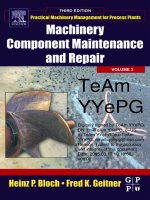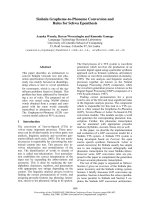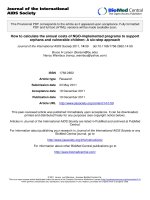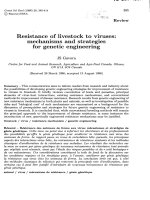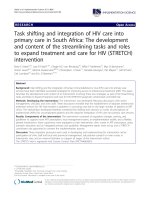design manufacture hydraulic pressing tools to support maintenance and repair for codia industrial solutions company
Bạn đang xem bản rút gọn của tài liệu. Xem và tải ngay bản đầy đủ của tài liệu tại đây (13.04 MB, 113 trang )
<span class="text_page_counter">Trang 1</span><div class="page_container" data-page="1">
<b> </b>
<b>TECHNOLOGY AND EDUCATION</b>
MINISTRY OF EDUCATION AND TRAINING
<b>HO CHI MINH CITY UNIVERSITY OF </b>
<b>DESIGN, MANUFACTURE HYDRAULIC PRESSING TOOLS TO SUPPORT </b>
<b>MAINTENANCE AND REPAIR FOR CODIA INDUSTRIAL SOLUTIONS COMPANY</b>
<b>LECTURER: M.S DUONG THI VAN ANHSTUDENT: LE HOANG KHANG</b>
<b>GRADUATION THESIS</b>
<b>FUNDAMENTALS OF MACHINE DESIGN </b>
<b>Ho Chi Minh City, March 2024</b>
</div><span class="text_page_counter">Trang 2</span><div class="page_container" data-page="2">MINISTRY OF EDUCATION AND TRAINING UNIVERSITY OF TECHNOLOGY AND EDUCATION
FACULTY OF MECHANICAL ENGINEERING
HO CHI MINH city, Mar 2024
</div><span class="text_page_counter">Trang 3</span><div class="page_container" data-page="3"><small>UNIVERSITY OF TECHNOLOGY AND EDUCATION THE SOCIALIST REPUBLIC OF VIETNAM </small>
<small>Independence – Freedom – Happiness </small>
<small>FACULTY OF MECHANICAL ENGINEERING </small>
<small>Fundamentals of Machine Design </small>
GRADUATION PROJECT EVALUATION FORM
<small>(</small>For the supervising teacher) Student participant: 1. Le Hoang Khang MSSV: 19143080 Điện thoại: 0372791095 Project name: Design, manufacture hydraulic pressing tools to support maintenance and repair for Codia industrial solutions company. Supervising teacher : M.S Dương Thị Vân Anh COMMENTS AND FEEDBACK 1. Comments on the student's spirit and work attitude. ......
...
2.2 Project Content: (Theoretical basis, practicality, and applicability of the project, potential directions for further research) ...
</div><span class="text_page_counter">Trang 5</span><div class="page_container" data-page="5">3. Evaluation:
Points
Points Obtained 1. Structure and Format of Thesis
Adherence to the prescribed format with complete structure and content of each section
Objective, tasks, and overview of the topic Relevance and urgency of the topic
Ability to improve and develop
Utilization of technical tools, specialized software, etc.
3. Evaluation of the applicability of the thesis 4. Specific Outputs of the Project
</div><span class="text_page_counter">Trang 6</span><div class="page_container" data-page="6"><small>UNIVERSITY OF TECHNOLOGY AND EDUCATION THE SOCIALIST REPUBLIC OF VIETNAM </small>
<small>Independence – Freedom – Happiness </small>
<small>FACULTY OF MECHANICAL ENGINEERING </small>
<small>Fundamentals of Machine Design </small>
GRADUATION PROJECT EVALUATION FORM
<small>(</small>For the Reviewing Teacher) Student participant: 1. Le Hoang Khang MSSV: 19143080 Điện thoại: 0372791095 Project name: Design, manufacture hydraulic pressing tools to support maintenance and repair for Codia industrial solutions company Name of the Reviewing Teacher: ...COMMENTS AND FEEDBACK 1. Comments on the student's spirit and work attitude. ...
...
...
2.2 Project Content: : (Theoretical basis, practicality, and applicability of the project, potential directions for further research) ...
...
...
</div><span class="text_page_counter">Trang 8</span><div class="page_container" data-page="8">3. Evaluation:
Points
Points Obtained 1. Structure and Format of Thesis
Adherence to the prescribed format with complete structure and content of each section
Objective, tasks, and overview of the topic Relevance and urgency of the topic
Ability to improve and develop
Utilization of technical tools, specialized software, etc.
3. Evaluation of the applicability of the thesis 4. Specific Outputs of the Project
</div><span class="text_page_counter">Trang 9</span><div class="page_container" data-page="9">i
<small>UNIVERSITY OF TECHNOLOGY AND EDUCATION THE SOCIALIST REPUBLIC OF VIETNAM </small>
<small>Independence – Freedom – Happiness FACULTY OF MECHANICAL ENGINEERING </small>
<small>Fundamentals of Machine Design </small>
MISSION OF THE GRADUATION PROJECT
Semester I / Academic Year 2024Advisor: M.S Dương Thị Vân Anh Athor’s name:
1. Lê Hoàng Khang ID: 19143080 Phone number: 0372791095 1. Project ID: CTM-04
Project name: Design, manufacture hydraulic pressing tools to support maintenance and repair for Codia industrial solutions company
2. Initial Data and Documents:
Overall dimensions of the machine: 562x400x1345 (mm) The machine is designed with a load capacity of 10 tons.
The bending machine shapes steel bars under 6 mm into a V-shape.
The result of the bending angle reaching 90 degrees falls within the tolerance range of ±0.3 3. Main Content of the Project:
Comprehensive study on the principles of hydraulic pressing.
Calculation of pressing force and structural strength of the machine frame. 3D model design using Inventor software.
Model simulation using Inventor software. Fabrication and assembly of model components. Manufacturing of the V-shaped bending tool. Product experimentation.
4. Expected Products: Drawing set
Project report Product model
5. Project Handover Date: 09/09/2023 6. Project Submission Date : 14/03/2024
</div><span class="text_page_counter">Trang 10</span><div class="page_container" data-page="10">i
7.Language Presentation: Report: English ☑ Vietnamese ☐
Presentation: English ☑ Vietnamese ☐
Head of department Head of Major Faculty Advisor
<small>(Signature, Print Name) (Signature, Print Name) (Signature, Print Name)</small>
M.S Dương Thị Vân Anh
<small>□ Allowed for protected ... (INSTRUCTOR sign and print name) </small>
</div><span class="text_page_counter">Trang 11</span><div class="page_container" data-page="11">- Student ID: 19143080 Class: 19143CLA3
- Student's address: B Dormitory, Mac Dinh Chi Street, Tan Hoa Ward, Di An, Binh Duong, Vietnam
- Contact phone number: 0372791095 - Email:
Date of graduation project submission:
Commitment: "I hereby declare that this graduation project is the result of my own research and work. I have not copied from any previously published work without proper citation. If any violation is found, I am fully responsible."
Ho Chi Minh City, March 2024 Author
</div><span class="text_page_counter">Trang 12</span><div class="page_container" data-page="12">iii
ACKNOWLEDGMENT
To successfully complete this graduation project, we would like to express our heartfelt and deepest gratitude to the esteemed faculty and staff of the Ho Chi Minh City University of Technology, specifically the High-Quality Training Department.
In particular, we extend our gratitude to M.S Dương Thị Vân Anh, who provided us with dedicated guidance, motivation whenever we encountered difficulties and challenges, and offered advice and assistance, enabling us to complete this graduation project.
We sincerely thank the leadership team and technical staff of the Industrial Solution Company CODIA for creating favorable conditions for us to conduct our research, providing us with a working environment, standards, and relevant materials during the research and experimentation phases of our project.
Once again, we thank the professors and lecturers on the graduation project defense panel for dedicating their precious time to listen to our presentation and provide valuable and constructive feedback.
Despite our best efforts to produce the best possible graduation project, we acknowledge that due to time and budget constraints, along with the limited experience and skills, some errors may be present. We eagerly welcome any contributions and suggestions from the respected faculty and the company to help us improve continually.
We sincerely thank you!
Author Le Hoang Khang
</div><span class="text_page_counter">Trang 13</span><div class="page_container" data-page="13">Nhận thấy được những vai trị tầm quan trọng đó và được sự cho phép và sự hỗ trợ tận tình của ThS. Dương Thị Vân Anh và Công ty giải giáp công nghiệp CODIA nên chúng em quyết định tìm hiểu và nghiên cứu đồ án tốt nghiệp của nhóm với đề tài là: “Thiết kế, chế tạo dụng cụ ép thủy lực hỗ trợ bảo trì sửa chữa cho cơng ty giải pháp công nghiệp CODIA” để phục vụ cho nhu cầu sản xuất và bảo trì của cơng ty.
Những cơng việc nhóm đã thực hiện trong đề tài: - Tìm hiểu về nguyên lý ép thủy lực.
- Khảo sát các loại máy ép thủy lực hiện nay trên thị trường - Nghiên cứu cụm chày cối uốn bát chữ V
- Thiết kế tính tốn và hồn thiện bản vẽ
- Gia cơng và đặt mua các chi tiết để tiến hành lắp ráp
- Kiểm nghiệm, đánh giá sản phẩm ghi nhận kết quả và cải thiện chất lượng
</div><span class="text_page_counter">Trang 14</span><div class="page_container" data-page="14">Recognizing these important roles and with the permission and enthusiastic support of Ms Dương Thị Vân Anh and CODIA Industrial Solutions Company, we decided to explore and research the graduation project of our group with the topic: "Design, manufacture hydraulic press tool to support maintenance and repair for CODIA Industrial Solutions Company" to serve the production and maintenance needs of the company.
The tasks our group has undertaken in the project include: - Studying the principles of hydraulic pressing.
- Surveying the types of hydraulic presses currently on the market. - Research punch and die
- Designing and calculate finalizing the drawings.
- Machining and ordering parts to proceed with assembly.
- Testing, evaluating the product to record results and improve quality.
</div><span class="text_page_counter">Trang 15</span><div class="page_container" data-page="15">LIST OF FIGURES ... vii
CHAPTER 1: INTRODUCTION TO THE TOPIC ... 1
1.1 Urgency of the subject ... 1
1.1.1 Introduction to the Role of Hydraulic Press Machines in Maintenance. ... 1
1.1.2 Introduction to the Manufacturing Sector of Codia Company's Machinery. ... 1
1.1.3 The Role of Maintenance and Repair Inspection at CODIA Company ... 2
1.1.4 Current State of Maintenance and Repair Inspection Activities at Codia Company ... 2
1.5.2. Specific Research Methods ... 4
1.6. Structure of the Graduation Project ... 5
CHAPTER 2 RESEARCH OVERVIEW ... 6
2.1. Overview of Hydraulic Pressing Technology ... 6
2.1.1 Overview of Hydraulics: ... 6
2.1.2 Overview of the Hydraulic Pressing Method ... 7
2.2 Overview of the Metal workpiece Pressing Process: ... 8
2.3 Classification by machine frame shape ... 9
2.4. Overview of the Manual Hydraulic Press workpiece Method ... 10
</div><span class="text_page_counter">Trang 16</span><div class="page_container" data-page="16">2.5.Overview of the hydraulic pressing method using semi-automatic hydraulic press: .. 11
2.6 Some Automatic Press Machines on the Market: ... 12
CHAPTER 3 THEORETICAL BASIS ... 15
3.1. Operating Principle: ... 15
3.2. Theoretical Basis of Metal Bending ... 15
3.2.1. Definition and Characteristics of the Bending Process ... 15
3.2.2. Characteristics of the Bending Process ... 17
3.2.3. Neutral Layer ... 17
3.3. V-bending mold punch and die ... 17
3.4. Determination of Bending Force: ... 18
3.5 Hot rolled sheet ... 19
3.6. Hydraulic Pressure Gauge: ... 20
3.7.Hydraulic System: ... 20
3.8. Hydraulic Cylinder: ... 21
3.9. Some products bent on the current market. ... 21
CHAPTER 4 DESIGN OPTION SELECTION ... 23
4.1 Introducing CODIA Industrial Solutions Company ... 23
4.2. Machine Structure ... 24
4.3 Design Options ... 25
4.3.1 The design option regarding the machine frame ... 25
4.3.2 Design Options for the Machine: ... 27
4.4 Proceed with the design according to the selected option:... 29
4.4.1. Designing the Dimensions of the Machine Frame ... 29
4.4.2 Choosing the Type of Cylinder: ... 30
CHAPTER 5: DESIGN AND CALCULATIONS ... 33
5.1. Working Area Dimensions of the Bending Mold: ... 33
5.2. Calculate the punch: ... 36
5.3. Determination of Bending Force: ... 36
5.4. Calculation and durability testing: ... 38
5.5. Calculating the strength of the horizontal U-shaped steel bars on top of the machine: ... 38
5.6.Support pin analysis : ... 41
5.7.Support pin hole contact stress : ... 43
</div><span class="text_page_counter">Trang 17</span><div class="page_container" data-page="17">5.8 Hydraulic Drive System Calculation: ... 44
5.8.1. Hydraulic Cylinder Calculation: ... 44
5.8.2. Required Flow Rate for the Cylinder ... 46
5.8.3. Hydraulic Pipeline Calculation: ... 46
5.8.4. Suction Line Calculation: ... 47
5.8.5 Selecting the Power Pump: ... 48
5.8.6 Selecting the Electric Motor: ... 49
5.8.7 Selecting the Directional Control Valve: ... 49
5.8.8 Selecting the Safety Valve: ... 49
5.8.9 Pressure Gauge and Gauge Cock Selection: ... 50
5.8.10 Filter Selection: ... 50
5.8.11 Function and Role of the Oil Tank: ... 51
5.9. Testing the bending process ... 51
5.10. Applying Inventor software to check the strength of the machine frame: ... 52
5.11 Using Inventor software to simulate the stress of a hole under an applied force. ... 54
CHAPTER 6: MANUFACTURING AND EXPERIMENTATION ... 56
6.1 Manufacturing the Machine Frame ... 56
6.2. Manufacturing the Punch and Die ... 58
6.3. Manufacturing the Workbench Support Components: ... 59
6.4 Machining of support pin ... 60
6.5 Assembly Process ... 61
6.6. Control System Design ... 63
6.7. Establishing an Overview Hydraulic Circuit Diagram ... 64
6.8. Machine Finalization and Testing ... 65
6.9 Experimentation Process ... 66
6.10 Inspect the product on the CMM machine ... 82
6.11 Experimental Evaluation and Conclusion ... 84
6.12 Safety Measures and Maintenance of the Machine ... 84
CONCLUSIONS AND RECOMMENDATIONS ... 85
REFERENCES ... 86
TECHNOLOGY TRANSFER CONFIRMATION DOCUMENT ... 87
</div><span class="text_page_counter">Trang 18</span><div class="page_container" data-page="18">vi
LIST OF TABLES
Page
Table 2.1 Specifications of plastic bottle and carton hydraulic press ... 14
Table 4.1 Machine Frame Dimensions Specifications ... 30
Table 4.2 Machine Data ... 31
Table 5.1 Specifications of the V-bending Die ... 34
Table 5.2 V die dimension specifications after calculation ... 36
Table 5.3 Durability limit of steel ... 37
Table 5.4 Pressure to flatten q (Kg/mm²) when bending a V-shaped ... 37
Table 5.5 TCVN 7571-11:2006 ... 40
Table 6.1 The data obtained after experiment 1 ... 67
Table 6.2 The data obtained after experiment 2 ... 68
Table 6.3 The data obtained after experiment 3 ... 69
Table 6.4 The data obtained after experiment 4 ... 70
Table 6.5 The data obtained after experiment 5 ... 71
Table 6.6 The data obtained after experiment 6 ... 72
Table 6.7 The data obtained after experiment 7 ... 73
Table 6.8 The data obtained after experiment 8 ... 74
Table 6.9 The data obtained after experiment 9 ... 75
Table 6.10 The data obtained after experiment 10 ... 76
Table 6.11 Data table obtained after testing 10 parts with a thickness of 4mm ... 79
Table 6.12 Data obtained after bending with a thickness of 3mm ... 80
Table 6.13 Data obtained after bending with a thickness of 6mm ... 81
</div><span class="text_page_counter">Trang 19</span><div class="page_container" data-page="19">vii
LIST OF FIGURES
Page
Figure 1.1 Using a hydraulic press for bearing repairs ... 1
Figure 1.2 Some machines of CODIA company ... 1
Figure 1.3 Spring roll machine ... 2
Figure 1.4 The V-shaped plates used to secure pneumatic cylinder ... 2
Figure 1.5 The V-shaped plates are used to support the rulo shaft ... 3
Figure 2.1 The operation of hydraulics ... 7
Figure 2.2 Hydraulic Wood Press Machine ... 8
Figure 2.3 Sheet Metal Cutting ... 9
Figure 2.4 Bending Process ... 9
Figure 2.5 C- frame press ... 10
Figure 2.6 H-frame press ... 10
Figure 2.7 Manual Hydraulic Pressing ... 11
Figure 2.8 Diagram of Manual Hydraulic Pressing ... 12
Figure 2.9 Semi-automatic hydraulic press ... 12
Figure 2.10 Semi-automatic hydraulic press Diagram ... 13
Figure 2.11 Hydraulic brick press ... 13
Figure 2.12 Plastic bottle and carton press machine ... 15
Figure 3.1 Bending Process ... 17
Figure 3.2 Punch and Die ... 17
Figure 3.3. Neutral Layer Chart ... 18
Figure 3.4 V-block Bending Die ... 19
Figure 3.5 The force exerted deforms the metal sheet by the punch ... 20
Figure 3.6 Pressure gauge ... 21
Figure 3.7 Hydraulic Power Unit ... 21
Figure 3.8 Hydraulic Cylinder ... 22
Figure 3.9 V-shaped Steel ... 22
Figure 3.10 The V-shaped is used to secure the components in the machine part ... 23
</div><span class="text_page_counter">Trang 20</span><div class="page_container" data-page="20">viii
Figure 4.1 The spring roll machine with V-shaped details needs maintenance ... 24
Figure 4.2 The V-shaped parts in the spring roll rolling machine ... 24
Figure 4.3 Hydraulic Press Structure ... 26
Figure 4.4 Hydraulic press machine with an H-frame ... 26
Figure 4.5 Hydraulic press machine with an C-frame ... 27
Figure 4.6 Manual Hydraulic Press ... 28
Figure 4.7 Semi-automatic hydraulic press ... 29
Figure 4.8 Overview of the Design and Dimensions of the Machine Frame ... 31
Figure 4.9 Double-acting Hydraulic Cylinder ... 32
Figure 5.1 Structure of the V-shaped Bending Mold ... 33
Figure 5.2 Dimensions of the V-shaped Bending Mold ... 33
Figure 5.3 The punch and die components are designed practically ... 34
Figure 5.4 Cross-section of the U-shaped steel 120x55x6,3 ... 39
Figure 5.5 Cross-section of the 2 U-shaped steel 120x55x6,3 ... 41
Figure 5.6 Support pin for the workbench ... 42
Figure 5.7 Force acting on the support pin ... 42
Figure 5.8 Cross-sectional image of the support pin ... 43
Figure 5.9 Contact area of the load-bearing bar ... 44
Figure 5.10 Estimated contact area ... 44
Figure 5.11 Parameters Hydraulic Cylinder ... 45
Figure 5.12 The symbol for a 4/3 hand-lever operated directional control valve ... 49
Figure 5.13 Bending with a thickness of 4mm in Inventor software ... 51
Figure 5.14 Direction of the force acting on the machine frame ... 52
Figure 5.15 The stress of the machine frame ... 52
Figure 5.16 The simulation results of testing the safety factor of the machine frame ... 53
Figure 5.17 The simulation results for the displacement of the machine frame ... 53
Figure 5.18 Direction of the applied force on the hole ... 54
Figure 5.19 The stress of the hole ... 54
Figure 5.20 The simulation results of testing the safety factor of the hole ... 55
Figure 5.21 The simulation results for the displacement of the hole ... 55
Figure 6.1 Machine Frame Designed in Inventor Software ... 56
</div><span class="text_page_counter">Trang 21</span><div class="page_container" data-page="21">ix
Figure 6.2 Drilling Holes on the Bench Drill Machine ... 56
Figure 6.3 Welding the U-shaped steel bars ... 56
Figure 6.4 Grinding the edges of the U-shaped steel bar ... 57
Figure 6.5 Welded joints after welding ... 57
Figure 6.6 Punch and Die Designed in Inventor Software ... 57
Figure 6.7 Machining the punch Component ... 58
Figure 6.8 Punch and Die after Machining and Painting ... 58
Figure 6.9 Workbench Support Frame in Inventor Software ... 59
Figure 6.10 Drilling Holes on the Bench Drill Machine ... 59
Figure 6.11 The workbench support component has been painted ... 59
Figure 6.12 Round steel support pin in Inventor software ... 60
Figure 6.13 Support pin after machining ... 60
Figure 6.14 Assembling the Workbench Support Frame ... 60
Figure 6.15 The workstation is mounted onto the machine frame ... 61
Figure 6.16 Assembling the Punch and anvil components onto the metal plate ... 61
Figure 6.17 The punch and die after assembly with the metal plate ... 61
Figure 6.18 The punch and die are connected to the machine frame ... 62
Figure 6.19 The hydraulic press machine after being painted ... 62
Figure 6.20 Algorithm Flowchart ... 63
Figure 6.21 Hydraulic schematic ... 64
Figure 6.22 Eke is used to measure perpendicularity ... 66
Figure 6.23 Experiment of V-shaped pressing 1 ... 67
Figure 6.24 Product from Experiment 1 ... 67
Figure 6.25 Experiment of V-shaped pressing 2 ... 68
Figure 6.26 Product from Experiment 2 ... 68
Figure 6.27 Experiment of V-shaped pressing 3 ... 69
Figure 6.28 Product from Experiment 3 ... 69
Figure 6.29 Experiment of V-shaped pressing 4 ... 70
Figure 6.30 Product from Experiment 4 ... 70
Figure 6.31 Experiment of V-shaped pressing 5 ... 71
Figure 6.32 Product from Experiment 5 ... 71
Figure 6.33 Experiment of V-shaped pressing 6 ... 72
Figure 6.34 Product from Experiment 6 ... 72
</div><span class="text_page_counter">Trang 22</span><div class="page_container" data-page="22">x
Figure 6.35 Experiment of V-shaped pressing 7 ... 73 Figure 6.36 Product from Experiment 7 ... 73 Figure 6.37 Experiment of V-shaped pressing 8 ... 74 Figure 6.38 Product from Experiment 8 ... 74 Figure 6.39 Experiment of V-shaped pressing 9 ... 75 Figure 6.40 Product from Experiment 9 ... 75 Figure 6.41 Experiment of V-shaped pressing 10 ... 76 Figure 6.42 Product from Experiment 10 ... 76 Figure 6.43 Experiment of V-shaped with thickness 3 mm ... 80 Figure 6.44 Product from Experiment with a thickness of 3mm ... 80 Figure 6.45 Experiment of V-shaped with thickness 6mm ... 81 Figure 6.46 Product from Experiment with a thickness of 6mm ... 81 Figure 6.47 The workpiece is positioned on the CMM machine ... 82 Figure 6.48 Proceed with measurements on the CMM machine ... 83 Figure 6.49 The results obtained after the measurement process on the CMM machine ... 83 Figure 6.50 The product of the bending process is replaced into the machine ... 88
</div><span class="text_page_counter">Trang 23</span><div class="page_container" data-page="23">1
CHAPTER 1: INTRODUCTION TO THE TOPIC
1.1 Urgency of the subject1.1.1 Introduction to the Role of Hydraulic Press Machines in Maintenance.
In the context of the modern industry, hydraulic press machines play a crucial role not only in the production process but also in creating products for the replacement, maintenance, and repair of machine components within enterprises.
One of the primary applications of hydraulic press machines is in shaping and processing metal components according to desired sizes and shapes. With the ability to generate high pressure, this machine can perform strenuous processes such as flattening and reshaping previously manufactured components. By utilizing powerful hydraulic pressure, it can refurbish and restore damaged components, minimizing both time and costs compared to replacing entire parts. Hydraulic press machines are often used to press products on punch and dies, ensuring that the final products meet the requirements for maintenance and repair.
Figure 1.1 Using a hydraulic press for bearing repairs
1.1.2 Introduction to the Manufacturing Sector of Codia Company's Machinery.
Codia is a company specializing in consulting and designing specialized mechanical machinery, providing customized automated production lines for the food and agriculture industries. The company's expertise includes rapid prototyping design and precision mechanical processing.
Figure 1.2 Some machines of CODIA company
</div><span class="text_page_counter">Trang 24</span><div class="page_container" data-page="24">2
1.1.3 The Role of Maintenance and Repair Inspection at CODIA Company
The inspection, maintenance, and repair of certain parts within machinery and equipment systems after a period of use are crucial steps in a company's production process. The purpose of these inspections is to minimize downtime, ensure safety, and maintain operational efficiency so that the machinery can produce the highest quality products. However, the company currently lacks the necessary equipment for maintenance and repair. Therefore, acquiring some hydraulic presses to meet the maintenance and repair needs is essential for the company to meet the challenging maintenance and repair requirements it faces.
1.1.4 Current State of Maintenance and Repair Activities at Codia Company
As mentioned in section 1.3, the Company is currently facing many difficulties in maintenance and repair due to lack of support tools, forcing it to buy new components to replace, leading to high costs. Specifically, during the maintenance and operation of the spring roll rolling machine, some V-shaped parts used to fix the pneumatic cylinder assembly, roller assembly and motor... were bent or randomly damaged. So it needs to be replaced or bent back to the correct 90 degree angle.
Figure 1.3 Spring roll machine
Figure 1.4 The V-shaped plates used to secure pneumatic cylinder
</div><span class="text_page_counter">Trang 25</span><div class="page_container" data-page="25">3
Figure 1.5 The V-shaped plates are used to support the rulo shaft
For the reasons mentioned above and the significance as stated, our team has decided to choose the topic "DESIGN AND MANUFACTURE HYDRAULIC PRESS TOOLS TO SUPPORT MAINTENANCE AND REPAIR FOR CODIA INDUSTRIAL SOLUTIONS COMPANY." This is to serve the purpose of improving product quality, optimizing maintenance, and developing new types of automated machinery to benefit the company specifically. Through this topic, the student group hopes to apply the knowledge they have learned into practice to manufacture and contribute a small part to the development of our country's current industry.
1.1.5 Subject Limitations.
The company's maintenance and repair products are very diverse, such as bearings, metal sheet flattening. However, the company only requires the manufacture of hydraulic presses with an anvil and mortar assembly that can press V-shaped pieces with a thickness of less than 6mm and a bending angle of 90 degrees, in order to replace and maintain the V-shaped parts of machinery. This also serves to evaluate the effectiveness that the machinery brings, from which there are demands for improvements, upgrades, or new constructions to test and maintain replacements as per the company's necessary requirements.
1.2. The practical significance of the topic
Upon completion, the project will be immediately implemented in production at CODIA Company to address the specific challenges that the company is currently facing. The V-shaped components produced will be supplied for the replacement, maintenance, and repair of the company's machinery and equipment.
For the team of authors, the project presents an opportunity to review and gain a deeper understanding of theoretical concepts they have learned. It offers a chance to enhance skills, acquire experience, and gain a deeper insight into the practical application of the knowledge obtained.
</div><span class="text_page_counter">Trang 26</span><div class="page_container" data-page="26">4 1.3.General Objectives
- Understand the functions, principles, control mechanisms, and models of hydraulic presses.
- Design and manufacture components based on the design of existing hydraulic presses on the market to make them more practical and applicable to production.
- Design and manufacture the assembly of the V-shaped punch and die for maintenance and repair purposes.
- Search for relevant documents and conduct related research. Specific objectives:
- Research the principles of hydraulic pressing and the assembly of the V-shaped punch and die.
- Survey the types of hydraulic presses currently available on the market. - Design and finalize drawings.
- Manufacture and order the necessary components for assembly. - Test, evaluate the product, and record the results.
1.4. Research Objectives and Scope 1.4.1. Research Objectives:
- Hydraulic Press Machine.
- V-shaped Metal Bending punch and die.
- Design Software for creating models and publishing drawings. - Machine structure and relevant calculated parameters.
1.5.2. Specific Research Methods
Document Collection and Synthesis Method: Gathering, analyzing, and translating documents related to hydraulic pressing technology. Ensuring diversity,
</div><span class="text_page_counter">Trang 27</span><div class="page_container" data-page="27">5
multidimensionality, and leveraging the findings of the latest research relevant to the topic of the study. Observing hydraulic press machine designs from previous versions. Reference materials are collected from books, textbooks, and the internet.
Utilization of Inventor 2020 Software: Using Inventor 2020 software for product design, followed by subsequent steps such as manufacturing and processing of materials.
Experimental Analysis Method: Based on the results obtained from experiments, appropriate machine parameters will be selected.
1.6. Structure of the Graduation Project
The Graduation Project "DESIGN AND MANUFACTURE OF HYDRAULIC PRESS TOOLING FOR MAINTENANCE AND REPAIR SUPPORT FOR CODIA INDUSTRIAL SOLUTIONS COMPANY" comprises six chapters:
Chapter 1: Introduction To The Topic Chapter 2: Research Overview
Chapter 3: Theoretical Basis
Chapter 4: Design Option Selection Chapter 5: <small>Design And Calculations</small>
Chapter 6: Manufacturing and Experimentation Conclusion and Recommendations
</div><span class="text_page_counter">Trang 28</span><div class="page_container" data-page="28">Figure 2.1 The operation of hydraulics
Pascal's law is a principle in fluid physics and it has a significant impact on the
operating principle of hydraulics. Pascal's law states that when pressure is applied uniformly to an incompressible fluid, this pressure is transmitted equally in all directions and remains equally strong at every point.
At a basic level, Pascal's law can be described by the formula:
𝑃 = <sup>𝐹</sup>𝐴In which :
P is the pressure (unit: bar)
F is the force applied to the fluid (unit: N)
A is the area over which the force is applied (unit: m²)
In hydraulic presses, this principle is used to create large forces by applying a small force over a small area. When the force is applied to the fluid, it creates pressure and moves the fluid to cylinders and pistons, which increases the force and produces a large output.
</div><span class="text_page_counter">Trang 29</span><div class="page_container" data-page="29">7
2.1.2 Overview of the Hydraulic Pressing Method
The hydraulic pressing method is a technique that employs fluid pressure to generate compressive forces or mechanical movement. In many applications, the fluid used is often hydraulic oil. The process consists of a basic hydraulic system, which includes a reservoir to hold the fluid, a pump to generate pressure, conduits for the fluid, control valves, and
hydraulic apparatus such as pistons or cylinders.
The hydraulic pressing method is utilized in processing a wide variety of materials, including metals, wood, and plastics.
Figure 2.2 Hydraulic Wood Press Machine
Hydraulic pressing offers the ability to create powerful compressive forces, aiding in the handling and forming of hard materials such as metals. It provides the capability to easily adjust the pressing force to meet the specific requirements of the product or manufacturing process. This method can be applied to various types of materials and is used in many different industries.
Hydraulic pressing is suitable for large-scale manufacturing processes and can be automated to enhance efficiency. Compared to some other manufacturing methods, the equipment costs for a hydraulic system can be relatively low.
Hydraulic systems are designed for high safety and often have long-term durability.Hydraulic pressing allows for the fabrication of complex details with high precision and the ability to be replicated multiple times.Hydraulic systems are generally easy to maintain and repair, helping to minimize production downtime due to malfunctions.
</div><span class="text_page_counter">Trang 30</span><div class="page_container" data-page="30">Sheet Metal Cutting
Cutting: Use laser cutting machines, plasma cutting machines, or mechanical cutting equipment to cut the sheet metal to the required size and shape.
Figure 2.3 Sheet Metal Cutting
Prepare the machine: Conduct a detailed inspection of the hydraulic press machine, examining each component, checking the hydraulic oil level, and determining the necessary pressure for bending processes based on the type of metal and thickness of the workpiece.
Bending: Apply bending force to the sheet metal to create specific angles and shapes. Hydraulic bending machines or mechanical bending machines may be used.
Prepare Mold and
workpiece <sup>Prepare the </sup><sub>machine </sub> <sup>Bending </sup> <sup>Check the </sup><sub>product </sub>
</div><span class="text_page_counter">Trang 31</span><div class="page_container" data-page="31">9
Figure 2.4 Bending Process
Inspection: The finished product is thoroughly inspected to ensure quality and accuracy according to requirements.
2.3 Classification by machine frame shape
In terms of machine shape and structure, there are hydraulic presses with C-frame, H-frame C- frame press: convenient for stamping, smoothing, and bending operations.
Figure 2.5 C-shaped press H- frame press
Figure 2.6 H-frame press
</div><span class="text_page_counter">Trang 32</span><div class="page_container" data-page="32">10 Advantages:
Capable of transmission with high power and pressure.
Simple mechanism, operates with high reliability, requires minimal maintenance. Compact and lightweight structure, the positions of driving and driven elements are
independent of each other.
Reduces the size and weight of the entire system by increasing working pressure. Overload prevention thanks to a safety valve.
Easy to monitor the hydraulic circuit with the help of a pressure gauge. Standardized components facilitate design and manufacturing.
Disadvantages:
Low efficiency due to pipeline losses and leaks from components.
At startup, changes in the system temperature lead to changes in the fluid's viscosity and, consequently, changes in the working speed.
Methods for control adjustment
The hydraulic system and electrical control system of the machine are designed to operate in 2 modes: manual mode and automatic mode.
The automatic mode can be easily adjusted in work logic sequence through the connection of electrical circuit diagrams and hydraulic circuit diagrams.
In manual operating mode, all motion processes of the cylinder are controlled by buttons or levers.
2.4. Overview of the Manual Hydraulic Press workpiece Method: Diagram of the manual hydraulic press:
The main method involves manually applying force to a hydraulic cylinder to make the cylinder press the workpiece.
Place the workpiece in the pressing position
Apply force manually to the
cylinder
Remove the pressed workpiece
from the die
</div><span class="text_page_counter">Trang 33</span><div class="page_container" data-page="33">11
Figure 2.7 Manual Hydraulic Pressing
Advantages: compact, easy to transport, suitable for pressing small quantities of products.
Disadvantages: mostly limited to producing small quantities, labor-intensive, products may not achieve high uniformity.
Figure 2.8 Diagram of Manual Hydraulic Pressing
2.5.Overview of the hydraulic pressing method using semi-automatic hydraulic press: Diagram of the automatic hydraulic press:
The main method involves using hydraulic cylinders controlled by a motor to replace manual labor.
Place the workpiece into the die
Adjusting pressure of
hydraulic system.
Carrying out the pressing
process
Take the workpiece
out of the bending die
Inspect products and
evaluate quality
</div><span class="text_page_counter">Trang 34</span><div class="page_container" data-page="34">12
Workers position the workpiece for pressing, adjust the appropriate pressure, and then activate the hydraulic cylinder to initiate the pressing process.
Figure 2.9 Semi-automatic hydraulic press
Advantages: Suitable for pressing large quantities of products with high productivity and precision.
Disadvantages: High manufacturing, maintenance, and operating costs.
Figure 2.10 Semi-automatic hydraulic press Diagram 2.6 Some Automatic Press Machines on the Market:
Domestic:
Based on the topic: RESEARCH INFLUENCE OF PRESSURE IN THE MOULDING OF SOIL BRICK BY SEMI-DRY METHOD by author Nguyen Tien Dung published in the Journal of Construction Science and Technology NUCE 2018 [15]. In this study, the author used a pressing machine Hydraulically shapes unburnt clay bricks using the semi-dry pressing method.
Through experimental research, we have built a relationship between pressing pressure and settlement of the product when pressed.
</div><span class="text_page_counter">Trang 35</span><div class="page_container" data-page="35">In this research, the authors studied the use of a pressure switch to enhance the power of the hydraulic press machine, which converts electrical energy into mechanical work without increasing the motor's output. The outcome of this research process is a machine used to compress 200kg of plastic bottles and cardboard boxes.
5 Weight Of The PressMachine 20000KN
7 Work Table Size 630×960 MM
Table2.1 Specifications of plastic bottle and carton hydraulic press
</div><span class="text_page_counter">Trang 36</span><div class="page_container" data-page="36">14
Figure 2.12 Plastic bottle and carton press machine.
</div><span class="text_page_counter">Trang 37</span><div class="page_container" data-page="37">15
CHAPTER 3 THEORETICAL BASIS
3.1. Operating Principle:Working Principle Diagram
The workpiece is placed on the mold of the machining table, then the hydraulic power is activated to start the pressing process. Under the force of the piston cylinder, the ram is pressed down, directly impacting the metal blank to deform it according to the V-Die, achieving a 90-degree angle, and ultimately producing the desired product.
3.2. Theoretical Basis of Metal Bending
3.2.1. Definition and Characteristics of the Bending Process
In metal sheet fabrication, V-bending is a common method used to shape a metal sheet at a specific angle, typically to form shapes like V, U, or other folded structures. There are two important concepts in this process: free bending and bottom bending.
Free Bending: Free bending is a bending method where the metal sheet is bent around a die without fully conforming to the die shape. This allows the metal to "slide" or move slightly during bending, which reduces the pressure needed to perform the bend and decreases the risk of cracking or breaking. Free bending is often used when the precision of the bend angle does not have to be extremely high or when a wide bend angle is required.
Bottom Bending: In bottom bending, the metal sheet is fully pressed against the die, creating a more precise bend angle. This process requires higher bending pressure than free bending but produces more accurate and clean bends, with less deformation. Bottom bending is suitable for applications requiring high precision in shape and size.
Both methods have their advantages and disadvantages, and the choice between them depends on the specific requirements of the product, including the precision of the bend angle, the type of material, and the thickness of the metal sheet. Free bending is generally quicker and less expensive, while bottom bending provides better precision and surface finish.
The hydraulic cylinder proceeds to press The workpiece is
placed on the V die
Start the hydraulic power source
</div><span class="text_page_counter">Trang 38</span><div class="page_container" data-page="38">16 Factors Affecting Bending:
Bend Radius: The smaller the bend radius, the greater the force required for bending. The bend radius also affects the degree of stretching of the outer surface and compression of the inner surface of the material during bending.
Material Thickness: The greater the thickness, the greater the bending force required. Material thickness also affects the material's ability to bend flexibly.
Material Properties: Material properties such as hardness, elasticity, and yield strength affect the bending process.
Figure 3.1 Bending Process [1]
Figure 3.2 Punch and Die
V-Die
</div><span class="text_page_counter">Trang 39</span><div class="page_container" data-page="39">17 3.2.2. Characteristics of the Bending Process
Under the pressure of the punch , the workpiece undergoes plastic deformation in each region to form the required shape. The deformation process also includes elastic deformation and plastic deformation.
Figure 3.1 illustrates the continuous V-bending process. Initially, the punch only contacts the workpiece at the punch tip. As the punch moves down, it bends the workpiece and gradually reduces the bend radius. Finally, the workpiece is tightly compressed between the punch and die, the V-shaped bar is straightened and the top has the smallest bending radius along the tip of the punch.
3.2.3. Neutral Layer
During the bending process, the metal layers on the inner side of the bend (the punch side) undergo compression and contraction in the vertical direction while experiencing tension horizontally. Conversely, the metal layers on the outer side (the die side) are subjected to tension and elongation in the vertical direction, compressing horizontally. Between the shortened and elongated layers lies a neutral layer (Figure 3.3), with its length equal to theinitial length of the workpiece .
In this way, it can be seen that the neutral layer is not a physical layer with specific characteristics; rather, it is a conventionally defined curved surface traversing different layers of laminates. When bending thin strips, significant deviations in the cross-sectional shape occur, accompanied by a reduction in the material thickness at the bending location. The neutral layer shifts towards the compressed side, and a change in the rectangular shape of the cross-section forms a trapezoid.
Figure 3.3. Neutral Layer Chart [1] 3.3. V-bending mold punch and die
Technical requirements for the bending die: Precision and durability.
Safety of die components.
Ease of replacement of worn parts.
</div><span class="text_page_counter">Trang 40</span><div class="page_container" data-page="40">18 Convenient die installation on the machine. Economical manufacturing.
Convenient operation.
The working parts of the bending mold (punch and die) often operate under conditions of impact, high pressure, corrosion, and sometimes in hot environments. Their shapes are usually complex and must maintain their shape after heat treatment.
Therefore, the materials used for bending molds need to have high hardness, high strength, and good resistance to wear. For this press machine, the mold material is made from SKD11 steel.
After the ram and die are machined to the correct size and shape as required, we proceed to heat treat the SKD11 steel at a temperature of 980-1050 degrees Celsius to achieve a hardened structure. Then, we temper the steel at a temperature of 200-300 degrees Celsius to balance its hardness and toughness, providing good impact resistance during the machining process. SKD11 steel is a type of hardened steel with a hardness ranging from 58 to 62 HRC, known for its high wear resistance, commonly used in applications such as knives, bending molds, and precision cutting tools.
Figure 3.4 V-block Bending Die 3.4. Determination of Bending Force:
Determining the bending force required to bend a workpiece at a certain angle using a die is a very challenging problem, and can only be estimated approximately. This is because the bending force depends on many factors such as:
Shape and cross-sectional size of the workpiece.
Mechanical properties of the material, distance between the supports.
Radius of curvature of the bending punch and working edge of the bending die.
</div>
